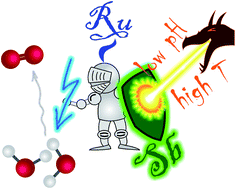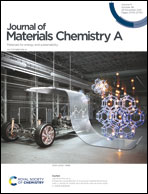Mixed metal–antimony oxide nanocomposites: low pH water oxidation electrocatalysts with outstanding durability at ambient and elevated temperatures†
Abstract
Proton-exchange membrane water electrolysers provide many advantages for the energy-efficient production of H2, but the current technology relies on high loadings of expensive iridium at the anodes, which are often unstable in operation. To address this, the present work scrutinises the properties of antimony–metal (Co, Mn, Ni, Fe, Ru) oxides synthesised as flat thin film electrodes by a solution-based method for water electrooxidation in 0.5 M H2SO4. Among the noble-metal-free catalysts, cobalt–antimony and manganese–antimony oxides demonstrate robust performance under ambient conditions, but slowly lose activity at elevated temperatures. A distinctive feature of the ruthenium–antimony system is its outstanding stability demonstrated herein through up to 8 day-long tests at 80 ± 1 °C, during which the reaction rate of 10 mA cm−2 was maintained at a stable overpotential of 0.34 ± 0.01 V. The S-number for this catalyst is on par with those for the high-performance benchmark Ir-based systems. Density functional theory analysis and detailed physical characterisation reveal that this high stability is supported by the enhanced hybridisation of the oxygen p- and metal d-orbitals induced by antimony and can arise from two distinct structural scenarios: either formation of an antimonate phase, or nanoscale intermixing of metal and antimony oxide crystallites.

- This article is part of the themed collection: Showcasing recent research in materials chemistry from IIT Bombay, IIT Indore and IISc


 Please wait while we load your content...
Please wait while we load your content...